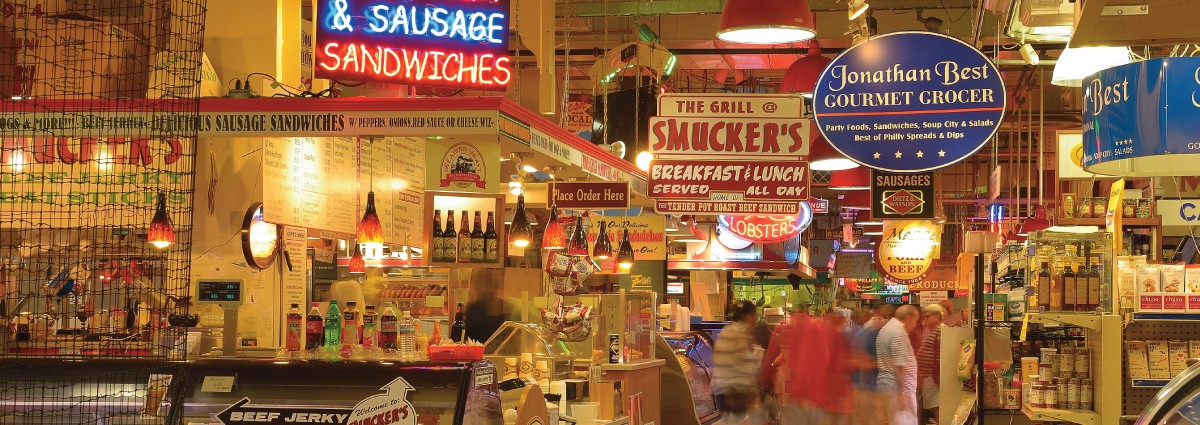
Reading Terminal Market envisions food and public space as ingredients for intercultural growth
Above: Busy shoppers and vendors inside Reading Terminal Market in Philadelphia. Photo courtesy of Reading Terminal Market.
Reading Terminal Market–Philadelphia’s downtown destination for all things edible and beyond–is gearing up to offer community members a chance to connect through their cuisine. Slated to get underway this fall, the market is busy organizing its upcoming “Breaking Bread, Breaking Barriers” project, funded by a Knight Cities Challenge grant. Using different cultures’ cooking as a starting point to open up dialogue amongst Philly’s varied ethnic, economic and religious groups, Reading Terminal hopes to bridge the divides between these pockets of the population.
Over the past decade or so, Philadelphia’s population has been steadily growing, partly due to an influx of young people, but also because its immigrant-friendly policies attract those seeking a new start. Representing one of the most diverse single locations in Philadelphia, Reading Terminal Market is uniquely positioned to cater to and connect these sometimes disparate segments of society.
“Food is one of the few common denominators we have left in society,” says Reading Terminal General Manager Anuj Gupta. “Every culture values good food.” Gupta explains that the market is free to enter and very affordable. With its many culinary offerings from fresh produce to ice cream, cheese, baked goods, fresh juice, coffee, delis, Amish cooking, Middle Eastern, Mexican, Indian and Pakistani food, along with much more, Reading Terminal unsurprisingly attracts a wide array of hungry visitors. This appeal makes it a destination not just for food, but for important cultural exchanges too.

Diners enjoying a meal outside on Filbert Street. Photo courtesy of Reading Terminal Market.
To tap into the common ground of these various groups, “Breaking Bread, Breaking Barriers” aims to connect leaders from different communities in the area over sit-down meals, which will be facilitated by the Philadelphia Commission on Human Relations. The food served will be prepared by local chefs selected to represent traditional and contemporary dishes from their respective cultures. By sharing a table and partaking in one another’s fare, the participants not only get a chance to savor their neighbors’ specialties, but also to engage in important dialogue with new acquaintances from potentially very distinct backgrounds. Using mealtime as a mechanism for social understanding, the hope is that the relationships cultivated here start at supper–as diners discuss the importance and evolution of the meals they enjoy–but continue far beyond the food.
Sociologist Elijah Anderson draws heavily on findings from his study of Reading Terminal Market and other Philadelphia public spaces for his 2011 book, “The Cosmopolitan Canopy.” In places like Reading Terminal, visitors hailing from a range of locations, economic standings and traditions can come together in an environment that allows them to bypass the often unconscious cultural barriers that surround every one of us. Under these so-called ‘cosmopolitan canopies,’ civility and openness may flourish. The mosaic that these destinations represent provides an ideal opportunity for tolerance and growth. There is also the promise of helping new Philadelphians feel welcome as they find their footing in a new city and, oftentimes, a new country.
While Reading Terminal is preparing to bridge social rifts by breaking bread with good company, it is also working to make its market space an even more accessible place. On its Filbert Street side to the south, Reading Terminal is experimenting with events and ideas that will help activate the underpass as a venue for additional programming. Filbert Street comprises a significant portion of the market’s outdoor perimeter, and as such, it is well suited for events like the monthly Franklin Flea and the Filbert Street Flower Market. Until recently, it has been a relatively underused asset; a somewhat dingy side street that has seen little investment. Having secured an ArtPlace America grant to turn the thoroughfare into an asset in its own right, Reading Terminal is already beginning a major lighting project that will set this transformation in motion.
“We are aiming to make Filbert Street more colorful and well lit. By activating the space with temporary programming and performances, we want to see how this affects our existing vendors so we can complement them in the process,” says Gupta. “It really has the potential to become a great public street.”
By helping communities share in the delights of mealtime, rethinking outdoor spaces and offering opportunities for cross-cultural learning, Reading Terminal Market seeks a bountiful future at the heart of Philadelphia’s creative and cosmopolitan consciousness. With a full plate of changes on the horizon, it’s just lucky that its patrons are so hungry.
Recent Content
-
Community Impactarticle ·
-
Community Impactarticle ·
-
Community Impactarticle ·


